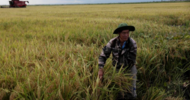
A combine harvests corn, Tuesday, Oct. 10, 2023, at a farm near Allerton, Ill. On Wednesday, the Labor Department releases producer prices data for October. (AP Photo/Joshua A. Bickel)
News Nation | 15 March 2024
Investors see big returns on farmland — are they pricing out farmers?
by Andrew Dorn
(NewsNation) — As the value of U.S. farmland continues to rise, investors looking to hedge against inflation have seen their returns skyrocket.
Over the past three years, the value of farmland held by investment groups has more than doubled, according to a Financial Times analysis of data from the National Council of Real Estate Investment Fiduciaries (NCREIF).
Part of that is a result of the pandemic. As COVID-19 upended supply chains across the world, the value of U.S. farmland shot up. A similar uptick happened after the Great Recession as investors tried to protect themselves from volatility in the stock market.
Since 2009, the average price for an acre of U.S. cropland has more than doubled from $2,640 to a record $5,460 in 2023, according to the United States Department of Agriculture (USDA).
As the global demand for food rises and the supply of arable land shrinks, investment managers like Nuveen — a subsidiary of the largest global investor in agriculture, TIAA — see farmland as an attractive asset class.
That outlook has enticed others, such as pension funds, the Church of Jesus Christ of Latter-day Saints and some of the nation’s ultrawealthy, to buy up agricultural land. Today, Bill Gates is the largest private owner of American farmland, with nearly 270,000 acres across more than a dozen states.
Jordan Treakle from the National Family Farm Coalition (NFFC) is concerned about the deep-pocketed investors. He worries they’ll price out smaller farmers and further consolidate the nation’s food supply.
“When you have a few players holding a lot of power in multiple parts of our food system, there’s less resilience, and that leads to less competition,” said Treakle, NFFC’s national program coordinator.
From 2017 to 2022, the U.S. lost nearly 142,000 farms, according to the latest Census of Agriculture. Over the same period, the average farm size increased by 5%.
American farmers are also getting older. The average age of all producers increased to 58.1 years, up from 57.5 in 2017. That means more land could hit the market soon.
Treakle fears that turnover could favor investors and hollow out rural communities.
“The No. 1 challenge for new and beginning farmers is access to farmland because of the price,” he said.
Rising land values create barriers for new farmers
Others, like Bruce Sherrick at the University of Illinois, say institutional investors have become more visible in recent years but pushed back against the idea that they’re buying up significantly more farmland and driving up prices.
“The majority of purchases are still by neighbors,” said Sherrick, director of the university’s TIAA Center for Farmland Research.
Because the supply of land is limited, those neighbors are also more likely to overpay when a nearby property becomes available, Sherrick noted.
Paul Schadegg, vice president of real estate operations at Farmers National Company, a farm management firm, said investors have “held the floor” when it comes to farm prices but agreed that individual farmers are more likely to bid up a nearby piece of land than an investor.
“Individual farmer buyers are going to have some emotion involved because they may need to expand an operation — it might be a farm that’s just come up for sale next to them,” Schadegg said.
Today, family-owned and operated farms still account for 95% of all U.S. farms, according to the latest data, but much of the nation’s agricultural land, nearly 40%, is rented. Most of the rented land is owned by non-operator landlords.
In July, U.S. Sen. Cory Booker, D-N.J., introduced legislation aimed at curtailing corporate investment in U.S. farmland. The bill, which the NFFC endorsed, would ban most corporations, pension funds and investment funds from buying or leasing farmland.
“This is a really critical period over the next decade to set some guardrails in place to make sure that our rural economies stay in the hands of the folks who are working the land,” said Treakle.
Sherrick doesn’t expect the legislation to advance and says that commercial farms are vital food producers whose efforts to improve efficiency have led to lower costs and increased supply.
By 2050, the United Nations estimates the world will need to produce 60% more food to feed the global population.
“Growing more using less inputs, that’s the story of agriculture, and it’s been quite remarkable,” Sherrick said.












